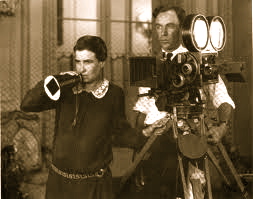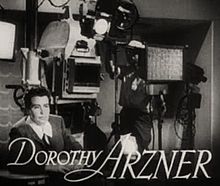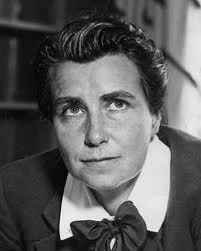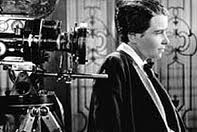Dorothy Arzner

Frame By Frame: Women Filmmakers
UNL Film Studies Professor Wheeler Winston Dixon recommends movies by women directors from the early years of cinema.
 Arzner in a trailer for The Bride Wore Red, 1937
Arzner in a trailer for The Bride Wore Red, 1937
Dorothy Arzner (January 3, 1897 – October 1, 1979) was an American film director. Her directorial career in feature films spanned from the late 1920s into the early 1940’s. Throughout that time she was the only woman working in the field.
Early life and career
Born in San Francisco, California, Arzner grew up in Los Angeles, where her father owned a restaurant frequented by many Hollywood celebrities. After finishing high school, she enrolled at the University of Southern California with hopes of becoming a doctor. During World War I, she left school to work overseas in the ambulance corps. By the time the war ended, she decided against returning to her medical studies and, after a visit to a movie studio, decided to pursue a career as a film director.
 Through connections with director William C. DeMille, Dorothy got a job at Paramount Pictures. She started out as a stenographer. She moved on to be a script writer, was promoted to film editor within six months and quickly mastered the job. Her first assignment as an editor was in 1922 for the renowned classic Blood and Sand, starring Rudolph Valentino. She was soon receiving accolades for the high quality of her work. Impressed by her technique, director James Cruze employed her as a writer and editor for several of his films. Arzner achieved a great deal of clout through this, along with her work on over fifty other films at Paramount. She eventually threatened to move to rival Columbia Studios unless given a directorial position. Paramount conceded in 1927, putting her in charge of the film Fashions for Women, which became a financial success.
Through connections with director William C. DeMille, Dorothy got a job at Paramount Pictures. She started out as a stenographer. She moved on to be a script writer, was promoted to film editor within six months and quickly mastered the job. Her first assignment as an editor was in 1922 for the renowned classic Blood and Sand, starring Rudolph Valentino. She was soon receiving accolades for the high quality of her work. Impressed by her technique, director James Cruze employed her as a writer and editor for several of his films. Arzner achieved a great deal of clout through this, along with her work on over fifty other films at Paramount. She eventually threatened to move to rival Columbia Studios unless given a directorial position. Paramount conceded in 1927, putting her in charge of the film Fashions for Women, which became a financial success.
 At Paramount, Arzner directed Clara Bow‘s first talkie, The Wild Party. To allow Bow to move freely on the set, Arzner had technicians rig a microphone onto a fishing rod, essentially creating the first boom mike. The Wild Party was a success with critics and was the 3rd top-grossing film of 1929. The film, set in a women’s college, introduced some of the apparent lesbian undertones and themes often cited in Arzner’s work. Her films of the following three years were strong examples of Hollywood before the Production Code. These films featured aggressive, free-spirited and independent women. She left Paramount in 1932 to begin work as an independent director for several of the studios. The projects she helmed during this period are her best known, with the films launching the careers of many actresses, including Katharine Hepburn, Rosalind Russell, Sylvia Sidney and Lucille Ball. In 1936, Arzner became the first woman to join the newly formed Directors Guild of America.
At Paramount, Arzner directed Clara Bow‘s first talkie, The Wild Party. To allow Bow to move freely on the set, Arzner had technicians rig a microphone onto a fishing rod, essentially creating the first boom mike. The Wild Party was a success with critics and was the 3rd top-grossing film of 1929. The film, set in a women’s college, introduced some of the apparent lesbian undertones and themes often cited in Arzner’s work. Her films of the following three years were strong examples of Hollywood before the Production Code. These films featured aggressive, free-spirited and independent women. She left Paramount in 1932 to begin work as an independent director for several of the studios. The projects she helmed during this period are her best known, with the films launching the careers of many actresses, including Katharine Hepburn, Rosalind Russell, Sylvia Sidney and Lucille Ball. In 1936, Arzner became the first woman to join the newly formed Directors Guild of America.
For reasons never fully disclosed, Arzner stopped directing feature-length films in 1943. She continued to work in the following years, directing television commercials and Army training films. She produced plays and, in the 1960s and 1970s, worked as a professor at the UCLA film school, teaching screenwriting and directing until her death in 1979.
Arzner died, aged 82, in La Quinta, California. She had been linked romantically with a number of actresses, but lived much of her life with her companion, choreographer Marion Morgan.
For her achievements in the field of motion pictures, Arzner was awarded a star on the Hollywood Walk of Fame at 1500 Vine Street.
In fiction
R.M. Vaughan‘s 2000 play, Camera, Woman depicts the last day of Arzner’s career. According to the play, Harry Cohn fired her over a kiss scene between Merle Oberon and fictitious actor Rose Lindstrom (in fact the name of a character played by Isobel Elsom in Arzner’s last film, First Comes Courage, in which Oberon starred) in a never completed final film. It also depicted Arzner and Oberon as lovers, and portrayed Arzner as a “typical” director who wants to “schtup” her leading lady. The play is told in a prologue, four acts, and an epilogue in the form of a post-show interview that contains actual quotations from Arzner. The implication is that First Comes Courage, while never actually named in the film, was taken out of Arzner’s hands and men added to the picture (the play depicts the film, which also starred Brian Aherne, Carl Esmond, and Fritz Leiber, Sr., being made as a war film with no men) against her wishes.
Directoral filmography of Dorothy Arzner, believed to be complete:
- Blood and Sand (1922) (additional footage) (uncredited)
- Inez from Hollywood (1924)(*editor)
- Fashions for Women (1927)
- Ten Modern Commandments (1927)
- Get Your Man (1927)
- Manhattan Cocktail (1928) (lost, except for the montage sequence by Slavko Vorkapić released in 2005 on DVD Unseen Cinema)
- The Wild Party (1929)
- Behind the Make-Up (1930) (uncredited)
- Sarah and Son (1930)
- Paramount on Parade (1930) co-director
- Anybody’s Woman (1930)
- The House That Shadows Built (1931) Paramount promotional film with excerpt of never-produced film Stepdaughters of War to be directed by Arzner
- Honor Among Lovers (1931)
- Working Girls (1931)
- Merrily We Go to Hell (1932)
- Christopher Strong (1933)
- Nana (1934)
- Craig’s Wife (1936)
- The Last of Mrs. Cheyney (1937) (uncredited)
- The Bride Wore Red (1937)
- Dance, Girl, Dance (1940)
- First Comes Courage (1943)



